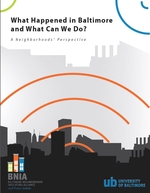A new report by the Baltimore Neighborhood Indicators Alliance—part of the University of Baltimore's Jacob France Institute (BNIA-JFI)—offers a clear set of data-driven objectives for community organizations, non-profits, elected officials and all stakeholders to work together to eliminate disparities in neighborhoods. The BNIA-JFI report, "What Happened in Baltimore and What Can We Do? A Neighborhood's Perspective," represents the synthesis of several years of work by the organization, and points to three key goals that could serve as a common agenda to improve quality of life in every neighborhood in the city.
"After the events of last spring, many people from around the world took a look at our data to better understand the neighborhood context that might have spawned such civil unrest," said Seema D. Iyer, associate director of the Jacob France Institute. "We put this report together to show that there are real issues in the places we live that impede healthy life outcomes. If we don't address these structural neighborhood problems, we won't give everyone a fair start or equal opportunity."
Based on both statistical analysis and community-based research, the key recommendations in the report include:
Increase housing diversity in every neighborhood: Based on research for the Opportunity Collaborative's Regional Housing Plan, the most stable housing markets in the Baltimore region are characterized by housing diversity and have moderate use of housing choice vouchers (a median of 20 vouchers per 1,000 housing units). Increasing housing diversity will provide realistic housing options for a range of household incomes and racial backgrounds. Ultimately, housing diversity matters because the strength of the housing market is correlated with educational outcomes for children.
Reduce or maintain vacant and abandoned housing below 4 percent in every neighborhood: As the report states, "Vacant and abandoned buildings are an issue of environmental justice. They represent the physical vestiges of population decline and their negative consequences rest on the shoulders of the people who currently deal with that loss every single day." Based on the experience in Baltimore, nearly all communities that grew between 2000 and 2010 had vacancy rates at or below 4 percent. For communities with significantly higher vacancy rates, the magnitude of this fact may seem overwhelming. Communities need to plan and focus together, with city agencies and outside resources, on the best course of action in their neighborhood to create a vision for a reality that includes a vacancy rate below the 4 percent threshold.
Reduce the percentage of households traveling more than 45 minutes to get to work: Research indicates that the impact on urban neighborhoods of long commute times is highly detrimental to population growth. Accessibility to work and other amenities for everyone in every neighborhood is the key to regional equity in the 21st century.
Examine the report, "What Happened in Baltimore and What Can We Do? A Neighborhood's Perspective."
Each year, BNIA-JFI issues Baltimore's Vital Signs report, which tracks more than 150 indicators to take the pulse of neighborhood health and vitality. The report is available on BNIA-JFI's website. The next edition will be released in March 2016.